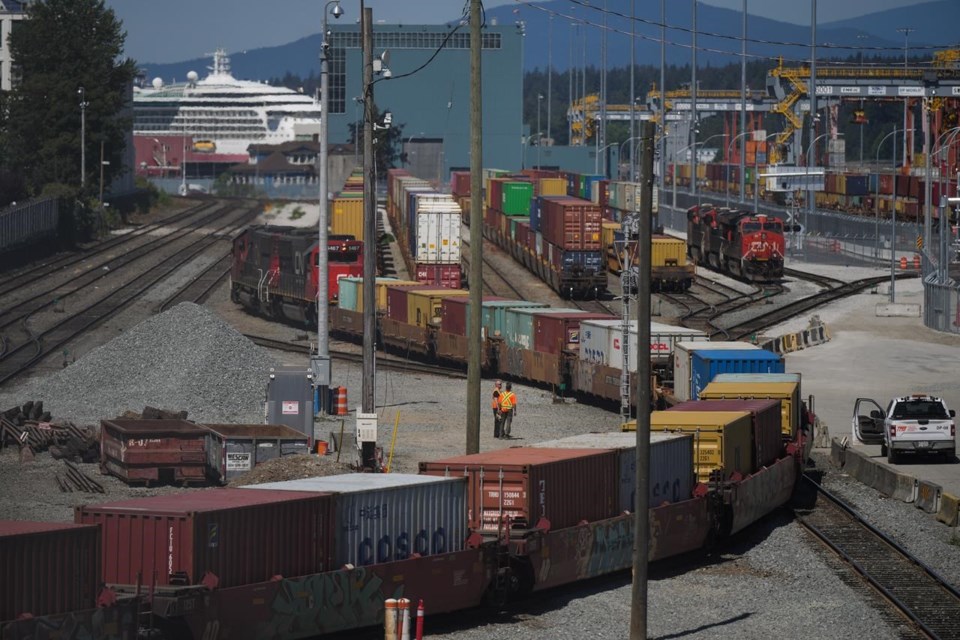The number of shipping containers passing through Canada's largest port fell sharply in the first half of the year, driven down by weaker consumer demand and a sputtering economy.
Container volumes at the Port of Vancouver fell 14 per cent in the first six months of 2023 compared with the same period a year earlier, the Vancouver Fraser Port Authority said Monday.
In a phone interview, interim CEO Victor Pang said the figures reflected a stalling economy, which contracted slightly in the second quarter.
"There's some economic softness, overall and for Canada. And you're seeing that through our container numbers," Pang said, noting that the decline was not unique to Canadian ports.
Consumer goods volumes fell 12 per cent year over year, a decrease driven mainly by lower demand but also overstocked inventories, he added.
Shipments of construction materials and auto parts also slumped, while movement of finished vehicles revved up as supply chain kinks smoothed out.
Grain exports more than doubled, making them the biggest bright spot. The increase was due to a bumper crop and a surge in demand after Russia's invasion of Ukraine disrupted a major grain market.
In spite of flat or falling volumes for most categories, the massive grain spike along with greater petroleum product exports fuelled an overall boost in goods at the port to 75.9 million tonnes for the first half of the year, an 11 per cent jump from 68.6 million tonnes the year before.
Nonetheless, Pang said the two-week strike by 7,400 B.C. dock and warehouse workers in July took a toll on operations, as month-over-month container shipments fell by a third and may have pushed some shippers to other ports — at least temporarily.
"Do they want to see more stability? Absolutely," he said of shippers. "There was no drastic change. But individual decisions, probably there were some ... The real question is, how much of it is going to stick?
"Hopefully they will see this as a one-off and not worry too much about their long-term confidence in the gateway. But I would not be surprised if they would assess this as one of the factors," Pang said.
The port, which handles more than $275 billion in goods each year, continues to clear the backlog created by the job action, he added. "But we're probably still another two months away from it being actually normal."
Escalating tensions between Canada and India after Prime Minister Justin Trudeau's announcement last week of a "potential link" between the fatal shooting of a local Sikh leader and the Indian government have yet to make a ripple at the port.
"We're obviously paying attention," Pang said. "I personally have not had any deep conversations with producers about this."
Canadian growers and agricultural distributors in fields such as potash and pulse crops — lentils in particular — rely heavily on the Indian market, one they hope will remain open after reprisals by New Delhi that included suspension of visa services for Canadians.
Greg Cherewyk, who heads Pulse Canada, said the industry group has faith in the sector's relationship with businesses in India — and in politicians' judgment.
“In a time of increasing food inflation and food scarcity, we are confident that affordability and availability will continue to drive decision-making at a government level," Cherewyk said in an emailed statement.
"Canada will continue to supply this important market with these important products."
Canada sends roughly $400 million worth of lentils to India annually, according to the organization.
Overall, crop shipments to India more than doubled to 264,000-plus tonnes in the first half of 2023 from a year earlier, according to the port authority.
Fertilizer and metallurgical coal exports sent to the subcontinent via the port ticked up between three per cent and five per cent to 653,000 tonnes and 1.4 million tonnes, respectively. Both numbers represent more than 10 per cent of the total for the two categories that passed through the Vancouver dockyards.
In April, the federal government approved a contentious container port expansion project at Roberts Bank south of Vancouver, an undertaking that would double its capacity.
Despite laying out 370 legally binding conditions to protect the environment and prevent harm to local species, the approval drew swift condemnation from environmentalists.
Pang said the timeline that would see the terminal go online by the early- to mid-2030s remains in place, with construction slated to begin toward the end of this decade.
The B.C. Environmental Assessment Office said earlier this year it is developing a final provincial assessment report on the project, seeking input from First Nations and the public.
A federal Fisheries Department authorization is also pending, Pang said.
This report by The Canadian Press was first published Sept. 25, 2023.
Christopher Reynolds, The Canadian Press



